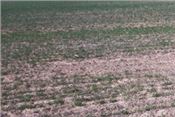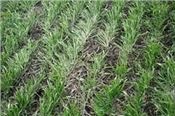|
Evaluating Winter Wheat Stands After A Tough Winter
GREGORY A. LUCE
COLUMBIA, MO.
Last fall it was extremely difficult to plant wheat in a timely manner across most of Missouri. Although there was some wheat planted at an ideal timeframe, much of the crop that did get planted in the state was very late and got very little growth going into the winter. We also had a colder, harsher winter than we have had in recent years. Wheat is very resilient and can recover from considerable winter conditions. However, the extremes this season, along with the lateness of the crop, are enough to have generated numerous questions about wheat stand potential. Making the decision, whether to keep a wheat stand, can be a tough call. Here are some factors to consider when deciding if a wheat stand is adequate:
• Wheat breaks dormancy at a soil temperature of about 39 degrees F. Allow about 10 days to two weeks of warm weather once green-up begins before counting stands.
• Winter survival can vary greatly across the field and is highly dependent on topography.
• Winter kill is most likely to occur in areas with little snow cover or winter wheat fields with little to no standing stubble to collect snowfall.
• Standing water, and ice covering wheat plants, for several days can suffocate the crowns. Stands are typically weakened in those areas and can have complete loss of plants.
• Exposed hilltops may also have less stand than protected areas of the field.
• A stand with 24 or more plants per square foot will be enough to maximize grain yield.
• If stand is relatively uniform across the field, 15 plants per square foot can still produce reasonable grain yields.
• A stand with 12 to 15 plants per square foot is the minimum that should be considered for grain harvest. A lower wheat stand population is best planted to another crop.
To properly assess a wheat stand, observe 10 to 15 locations across the field. Count the number of plants and/or tillers per square foot. There are several methods, such as using a hula hoop or square to measure plants within a given area. An easy way is to just simply use a tape measure or yardstick and measure the length of row equal to 1 sq. ft. Use the table below for the length to use with the appropriate row width:
Row Width Length of Row to Equal 1 sq. ft.
7” 20.5”
7.5” 19.25”
8” 18”
10” 14.4”
For example, with wheat planted in 7.5" rows, count the number of tillers or plants in a 19.25" length and that would be equal to the number in 1 sq. ft.
Plants per square Tillers per square Potential Yield
foot foot %*
30-35 90-105 100
24-28 72-84 100
18-21 54-63 90-95
15-18 45-54 75-80
12-14 36-42 60-70
6-7 18-21 40-50
When using tiller counts to determine the condition of wheat fields, only count tillers that have at least 3 leaves per plant.
The chart below is from Dr. Carrie Knott, Extension Grain Crops Specialist at the University of Kentucky and shows wheat yield potential for a range of tillers and plants per square foot. Adapted from a table in Section 3: Cultural Practices in A Comprehensive Guide to Wheat Management in Kentucky http://www2.ca.uky.edu/agcomm/pubs/id/id125/id125.pdf
*This provides an estimate of the relationship of wheat stand to yield potential and is only a guide. Many factors (plant vigor, weather, disease, fertility management, planting date, and variety) influence how a wheat stand ultimately responds to achieve its final yield potential.
Since much of the wheat crop did not have time for adequate tillering in the fall, it will be important to supply nitrogen early to help compensate for the delayed growth. For more information, see the IPCM article: Strategies for N on wheat this spring, by Peter Scharf published February 28, 2019. ∆
GREGORY A. LUCE: University of Missouri

Thin wheat stands will need to be evaluated following green-up.

Ideal wheat stands will have 25 plants per sq. ft. with 3-5 tillers per plant. 12-15 plants per sq. ft. is minimum guideline for grain production.
|
|